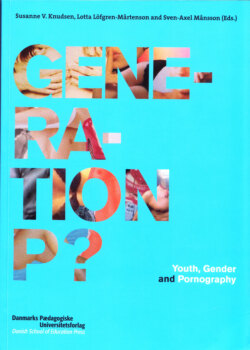Читать книгу Generation P? - Группа авторов - Страница 17
На сайте Литреса книга снята с продажи.
Pornotopia – Theoretical considerations and young pornographers By Nils Hammarén and Thomas Johansson Introduction
ОглавлениеContemporary youth are well acquainted with pornography (Johansson & Hammarén 2007). It is difficult to avoid taking a stand on it one way or another, and the topic has inspired heated debate and strong opinions.1 Opinions do shift, however, and although it is possible to find differing views in the discussion on pornography, Swedish society as well as many other European societies is marked by generally negative and critical attitudes. At the same time, however, it is clear that, at the political level, attitudes toward those who sell and profit by pornography are not as negative or critical. In many respects, young people are living in a society where pornography and a commercial market based on sexuality have a strong position. A liberal attitude toward the phenomenon is not uncommon, not least because censorship is thought to be a less attractive alternative to the openness that characterizes a free market. For example, most young people, regardless of gender, believe that everyone should have the same right to view pornography, and that all individuals should be able to choose what they wish to see or read (Hammarén & Johansson 2002). Pornography is considered by young people to be normal and “natural” (Löfgren-Mårtenson & Månsson 2006).
The media have great influence on how sexuality is presented and staged, and in the media, we find large numbers of talk shows, documentaries and films that offer vivid portrayals of human sexuality. People are deluged with these imaginary products, and though it is difficult to determine to what degree and in what way people are affected, we can certainly establish that this artificial world created by media helps to shape our ideas of sexuality, physicality and gender. The sexual education supplied by the media –thus, the term mediaized sexuality – has perhaps in some respects replaced both science and sex education as taught in the schools. This may involve varyingly subtle influences. Some pictures only evoke weak associations to pornography, while others are more explicit in nature. This raises an important question: how does this development influence young people and their ideas about sexuality and pornography?
Today, the idea that sexuality is something natural – something that just exists and works – is not completely self-evident. It is instead the case that sexologists, gender scholars, feminists, journalists, psychologists and sociologists help to create and construct, both consciously and unconsciously, our picture of sexuality. When one studies sexuality, one becomes a part of this apparatus. The entire contemporary discussion on sexuality – and on the sexuality of youth in particular – is a mix of different discourses and theories concerning how we should view sexuality and physicality. These discourses are intertwined with conceptions of gender, ethnicity, class, place etc. and construct different sexual practices and ideologies (Hammarén 2005). For example, the gap between the attitudes of young men and women is narrowing in some areas, while other areas are still marked by strong tendencies toward maintaining a traditional gender balance. Attitudes toward pornography remain largely divided along gender lines, but we are also able to observe how young men’s and young women’s lines of reasoning overlap. Today, young women are more likely to consume pornography and a relatively large proportion of them report becoming sexually aroused by it (Hammarén & Johansson 2002). However, young women are also the primary critics of pornography, although many young men also feel it is degrading in some respects (Johansson 2007).
The question is to what degree young people are able to distinguish between real-world sexuality and the discourses they find in the media world. Both of these realities have become increasingly blurred and intertwined so as to form a complex cultural fabric. In the following text, we will follow the path from Giddens’ and Foucault’s studies of sexuality to Baudrillard’s theories of post-modern sexuality. This will form the foundation of a theoretical discussion and analysis of sexual narrations and expressions in our time, exemplified with some empirical examples about youth and pornography.
